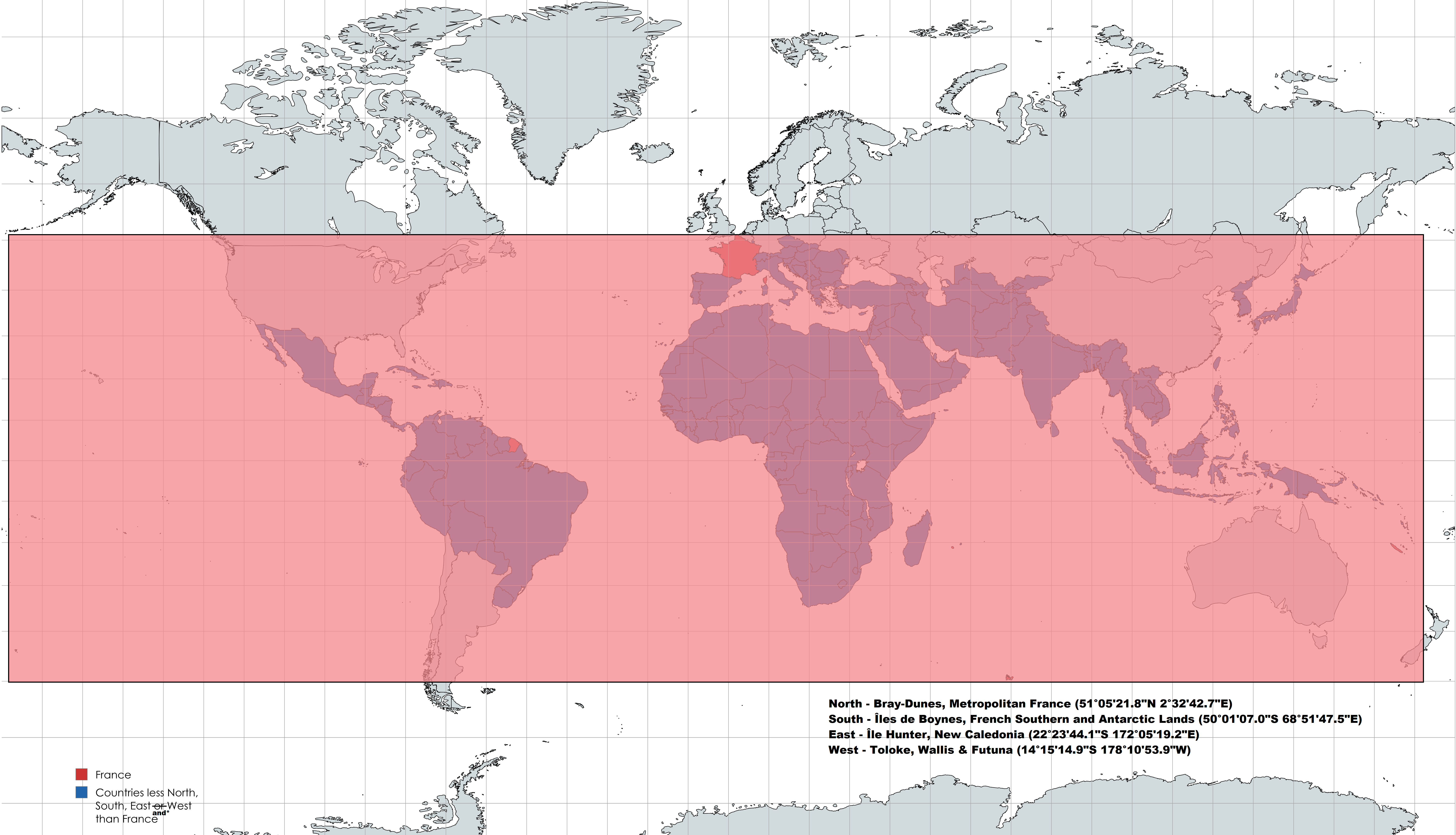France's Geographical Extremes Map


Alex Cartwright
Senior Cartographer & GIS Specialist
Alex Cartwright is a renowned cartographer and geographic information systems specialist with over 15 years of experience in spatial analysis and data...
Geographic Analysis
What This Map Shows
This intriguing map highlights an interesting geographical fact: France is positioned further North, South, East, and West than 163 of the 192 UN member states, excluding its Antarctic claims. At first glance, this might seem surprising, as many people often associate France predominantly with its continental territory. However, when we dive deeper, we uncover the unique geographical distribution of France's territories, which significantly influences its global positioning.
Deep Dive into France's Geographical Distribution
France's geographical extremities can largely be attributed to its overseas territories scattered across various oceans and seas. For instance, the French Southern and Antarctic Lands, while excluded from this analysis, play a crucial role in understanding France's far-reaching presence. Additionally, territories like Réunion in the Indian Ocean, Mayotte near the Comoros, and the various Caribbean islands (such as Guadeloupe and Martinique) contribute significantly to the country's geographical expanse.
Interestingly, the mainland of France, although compact in size compared to larger nations, extends from the northernmost point at Cap Blanc-Nez to the southernmost point at the Spanish border near the Mediterranean coast. The easternmost point is located near the city of Mulhouse, bordering Germany and Switzerland, while the westernmost point rests at Pointe de Corsen in Brittany.
What’s fascinating is that while France's mainland covers about 551,695 square kilometers, its overall territorial claims and overseas departments expand its total area to around 643,801 square kilometers. This includes regions with diverse climates and ecosystems, ranging from tropical in the Caribbean to subtropical in the Indian Ocean. Furthermore, France's overseas regions also encompass various time zones, making it a unique case in terms of geographical diversity.
To put things into perspective, consider how countries like Japan or Italy, which have similar land areas, do not extend as far in any direction as France does. The positioning of France offers it a strategic advantage in terms of trade routes and international relations, especially given its location at the crossroads of Europe.
Regional Analysis
Looking at the different regions of France, we can see how this geographical diversity manifests. The mainland of France, with its various climatic regions, influences agricultural production. For instance, the temperate climate in the north supports the cultivation of grains and vegetables, while the warmer climates in the south are perfect for vineyards and citrus fruits. Meanwhile, overseas territories like Réunion and Guadeloupe benefit from a tropical climate, allowing for the growth of sugarcane and spices.
Moreover, the demographics of these regions vary significantly. The mainland is predominantly urban, with major cities like Paris, Lyon, and Marseille serving as cultural and economic hubs. In contrast, the overseas territories often have smaller populations and face different socio-economic challenges, including higher unemployment rates and reliance on imports for many goods. For instance, Mayotte has seen rapid population growth, leading to increased pressure on its social services and infrastructure.
Additionally, the geographical positioning of these regions has led to distinct cultural identities. The Caribbean islands exhibit a blend of French, African, and indigenous influences, while territories in the Indian Ocean have their unique multicultural aspects, often influenced by the proximity to mainland Africa, Madagascar, and the Indian subcontinent.
Significance and Impact
Understanding France's geographical extremes is crucial for several reasons. Firstly, it sheds light on the country's historical colonial ambitions and current global influence. France's overseas territories allow it to maintain a presence in both the Atlantic and Indian Oceans, contributing to its status as a major player on the world stage.
Moreover, this geographical diversity has real-world implications for climate change and environmental policies. The varied climates and ecosystems within France require tailored approaches to conservation and sustainability. For instance, the tropical ecosystems in the Caribbean and Indian Ocean territories are particularly vulnerable to the effects of climate change, including rising sea levels and changing weather patterns.
In conclusion, France's unique geographical positioning is not just a trivial fact but a cornerstone of its national identity, cultural diversity, and global strategy. As we look towards the future, understanding these geographical nuances will be essential for addressing international relations, environmental challenges, and economic development. Have you ever considered how a country’s geography can influence its culture and economy in such profound ways? France serves as a perfect case study in this regard.
Visualization Details
- Published
- August 12, 2025
- Views
- 120
Comments
Loading comments...